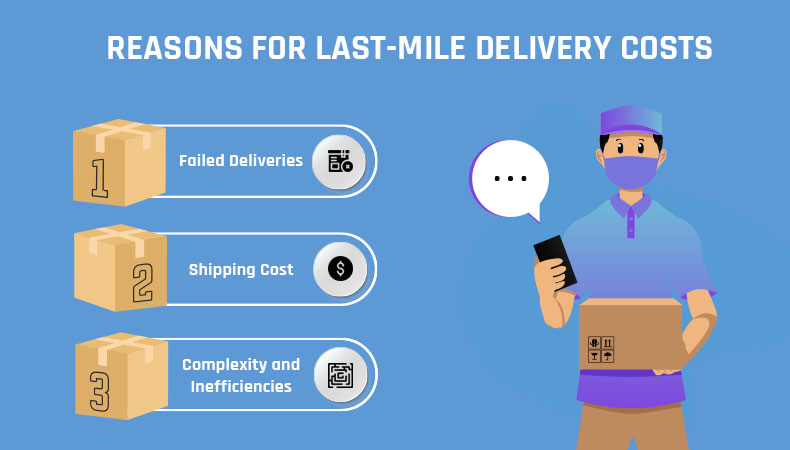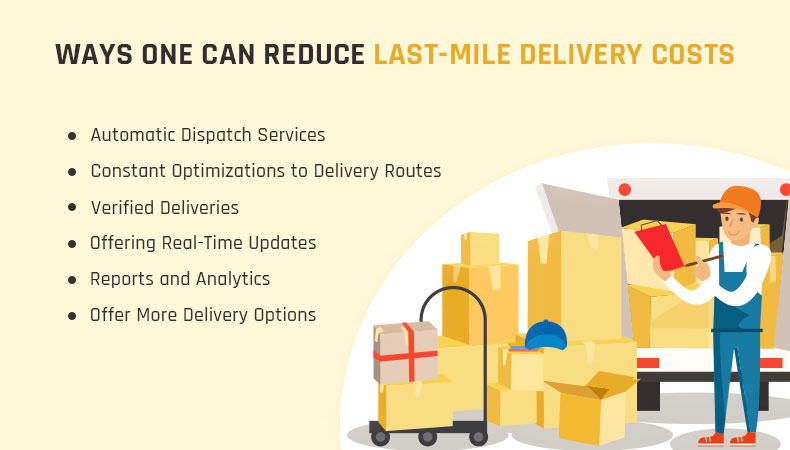Ways to Reduce Your Last-Mile Delivery Costs in Your Business

The delivery management systems of the present era have become sophisticated enough so that people miss the costs and profits involved with them. Due to the recent e-commerce boom, business to business logistics operations has increased in 33% demand. Business to consumer logistics demand was even higher, at 67% greater demand than normal. Delivery tracking mechanisms demand seems to be rising as all logistics systems are experiencing delivery requirements that are impossible to handle without an automated system. But installing such systems certainly requires an initial investment. But it has been consistently shown that overall costs can be reduced in the long run if such systems are installed.
The costs of such delivery management systems can be further reduced by understanding the complexity of how such a system works. Logistics and supply-chain companies that provide these systems have now become a central figure for other business companies that depend on them. The reduction happens when the software is finely tuned with the business model. We should also understand the common and uncommon ways costs get high. The drivers of last-mile delivery costs are closely linked to the overall costs of the business. Over 25% of companies said the efficiency of delivery was a concern. It was estimated that 26% of loss can be prevented by optimization of the last mile delivery process. Automated logistics have become a part of the culture and this has made keeping profit margins for such companies difficult.
Reasons for Last-Mile Delivery Costs
It is important to know the reasons for last-mile delivery cost within the delivery industry. This will become handy when understanding the ways to reduce such costs will get determined. Primarily there are 3 major reasons for last-mile delivery related costs.

Failed Deliveries
This is an obvious one that is hard to resolve. If the logistics company or the agent does not use software to track the delivery job, failure rates become high. While same-day delivery services are great and they make many things easier there are things that they cannot control without the software. One example is that the customer cannot figure out the exact time the delivery agent will knock on their door. Failed deliveries can be instances of customers not being present when the delivery agents arrive.
Shipping Cost
The delivery agencies are generally swayed by the customer demands as time progresses. Shipping cost is one of the things that now customers expect that the delivery companies take up. 57% of the 323 logistics companies in a survey said that their customers demand same-day deliveries. This makes the costs around the shipping of packages rise. But other statistics suggest that 93% of people prefer the companies that can provide free shipping services and can deliver on the same day. It is thus easy to see how software with its automated and efficient delivery management process helps meet up customer demands and keep up with the costs related to shipping.
Complexity and Inefficiencies
The complexity of last-mile delivery often is too much because the process itself depends on many parameters, both static and dynamic. Examples include urban area locations that may seem close to one other but may be hard to get to because of traffic or other conditions. The complexity has increased with the number of orders, at an exponential rate. These are hard to deal with without delivery tracking apps.
Ways One Can Reduce Last-Mile Delivery Costs
We have now seen what are the main drivers of costs in the delivery industry. There are many ways that shipping and delivery companies try to reduce the costs of the process. While some are easier to do with software, others should be done often to optimize the process and keep the costs under the limit. Following are the many ways one can reduce the costs of last-mile delivery solutions.

Automatic Dispatch Services
When multiple drivers or delivery agents are present near customers, it can become difficult to decide which delivery agent is going to pick up the order. Special algorithms can be used to figure this in a manner that increases the efficiency of the system. The algorithm checks many parameters, like each vehicle’s fuel and the traffic in the area. The algorithm makes sure that the cost for the customer and the company is kept at the most minimum possible. This is termed as the delivery auto dispatch mechanism and reduces the costs associated with manual dispatch.
Constant Optimizations to Delivery Routes
The costs of a particular delivery job are directly dependent on the distance between the delivery agent and the customer’s location. Obviously, the obstacles that the delivery agent faces in the route also matters. Because of the unpredictable nature of such obstacles, the delivery software constantly adjusts the route with what is known as route optimization technology. The optimization depends on following multiple factors
- Traffic
- Vehicle fuel
- Distance
- Location
The optimization process is automatic. Even when new deliveries arrive, the delivery agent can simply use the optimization feature to watch the next best moves in delivery
Verified Deliveries
The online order and delivery process do not exist without a verification process. The delivery agent after going to the customer location and successfully delivering the product is verified by the consumer. Digital signature of various forms can be used by the agent as proof of delivery. The digital signature form contains the following information
- Name of the delivery agent.
- where the package was delivered.
- Some form of consumer identification.
Important photos, barcodes and consumer identification can be easily taken in a matter of seconds by the application. The costs of misunderstandings between the consumer and the company can be reduced by this method.
Offering Real-Time Updates
In this day and age, transparency is highly valuable and can reduce any misunderstandings. This is why the delivery industry must be able to offer real-time updates on each delivery job. This also takes customer experience levels to a higher level. The admins of the logistics software can easily send customized notifications about their packages. Some of these notifications are automatic, like the ones that alert the customer about the package position when it is near their destination. Customers can also check the status of each of their orders. The last-mile delivery tracking system shows the following to its customers.
- Order status of being packed or shipped.
- Estimated time of arrival.
- Real-time location of the package.
When the customer is aware of their delivery status they are able to correctly receive their packages, reducing the number of failed deliveries.
Reports and Analytics
The admins of the delivery software are provided with an extensive list of reports and analytics. The delivery analytics are updated in real-time. This makes it easier for the business to make decisions that reduce the cost, both in the short and the long term. The following details are recorded in real-time and reports are generated based on them.
- Distance covered
- Idle time
- Average time per task
- Miles per delivery
- Number of successful and unsuccessful deliveries
The above data is represented in a graphical form for easy visualizations. The reports can also be viewed by week, month or as a yearly report. The reports contain important information about the business and can answer any questions regarding how costs can be lowered. The analytics also have information about each driver and vehicle, and the business can then optimize its fleet as well.
Offer More Delivery Options
The same-day delivery model, although popular, is not a good choice all the time. For example, customers who work most of the day and only return at night will not benefit from the feature. In such a case, the delivery agent who is unaware of the matter will rush to the destination in the working hours only to find the recipient not being there. Other more flexible delivery options can cut costs and be more beneficial for the customer. It was revealed by statistics that the following are the experiences customers would like to have in the delivery process.
- More than 73% of people preferred convenient time slots rather than a faster delivery service.
- 51% of people wanted real-time visibility of the packages.
- 65% of people wanted the delivery agent to be more flexible.
- 61% of people wanted more speed in the delivery process.
Conclusion
Last-mile delivery is a complicated but necessary system that is responsible for the efficient delivery of packages. Because it is complicated, people do not understand what are the overt and hidden costs in the system. Deliforce is an on-demand delivery management solution that can track delivery agents in real-time. It has many delivery scheduling features and can generate reports and provide detailed analytics of deliveries. Reports are generated from the date of using the application or integrating it with your logistics system for the first time.





